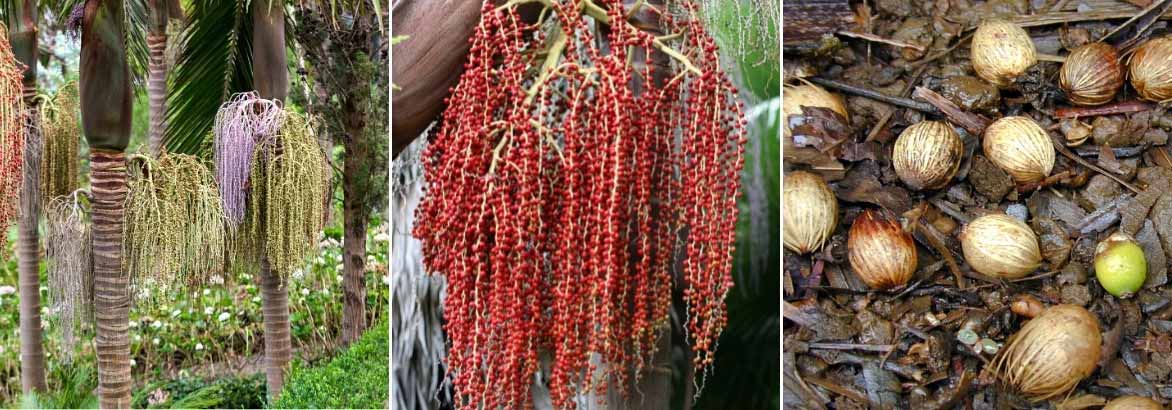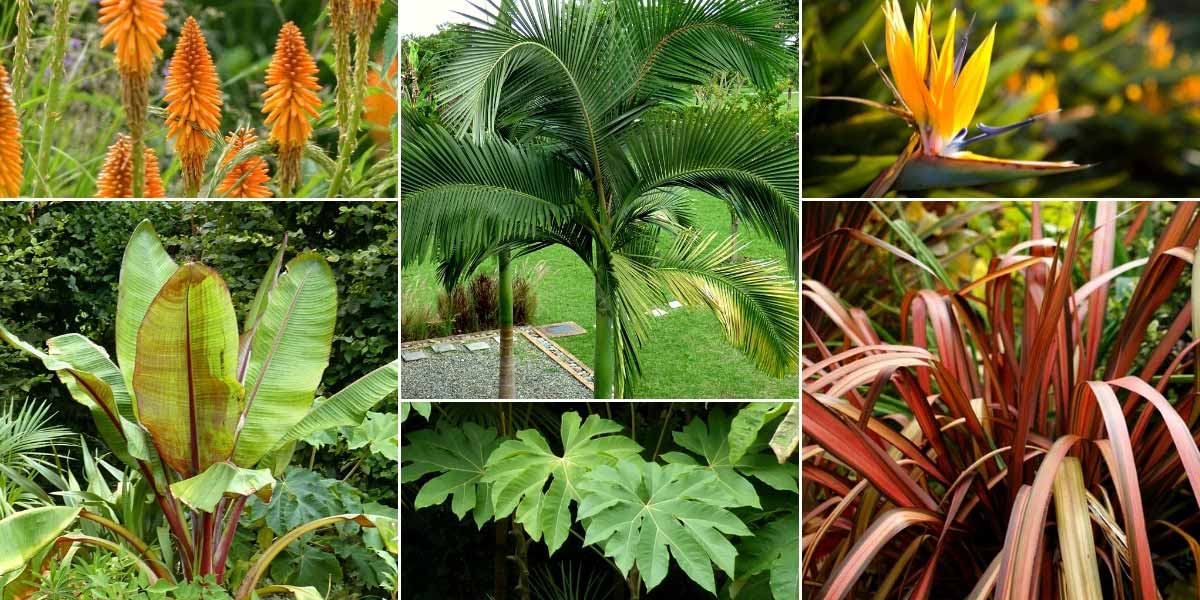
Archontophoenix: planting, growing and caring
Contents
The Archontophoenix in a nutshell
- The Archontophoenix is a majestic palm with a slender trunk topped by lush foliage
- It bears large, beautiful pinnate leaves, finely divided
- In summer, it produces panicles of small creamy-white or lilac flowers, followed by red berries
- It is ideal for creating an exotic and tropical atmosphere in the garden
- Not very hardy, it must be protected from the cold but adapts very well to container cultivation
The word from our expert
Native to Australia, the Archontophoenix is a majestic palm that forms a slender and elegant trunk, marked with horizontal striate rings, unfurling at the top an imposing crown of leaves. These are very large, arched, and feather-shaped, beautifully divided into long and narrow leaflets. They are green, with a strikingly silvery underside in the case of Archontophoenix alexandrae. The Archontophoenix blooms in summer, producing ramified panicles composed of numerous small cream-white or lilac flowers, followed by highly decorative red berries.
As the Archontophoenix is not hardy, planting it in the ground is best reserved for frost-free regions, such as the Mediterranean coast. In other areas, it can be grown in pots, allowing it to be easily moved indoors for winter. It will make a stunning exotic feature on the terrace in summer, alongside other lush-leaved plants like fatsias, tetrapanax, strelitzias, bananas, and bamboos.
Discover all our tips for successfully growing Archontophoenix, whether in the ground or in pots!
botany
Botanical data
- Latin name Archontophoenix sp.
- Family Arecaceae
- Common name royal palm
- Flowering July-August
- Height up to 20 m
- Sun exposure partial shade, non-scorching sun
- Soil type rich, moist and well-drained
- Hardiness frost-sensitive, 0 °C to – 2 °C
Archontophoenix comprises six species of palm trees native to the rainforests of Australia’s east coast. Unfortunately, they are not hardy, with most of them sensitive to temperatures below freezing, around 0 °C to – 2 °C. However, they adapt well to pot cultivation and can be grown in a cold greenhouse or conservatory. The species Archontophoenix cunninghamiana is one of the hardiest, tolerating temperatures as low as – 4 °C, making it suitable for outdoor cultivation in Mediterranean coastal regions.
Archontophoenix belongs to the large family of palm trees, the Arecaceae. They are not technically trees, as they do not form wood or branches and are not ramified. Botanically, they are more like giant herbs. They do not grow significantly in diameter but only in height. The “trunk” of a palm tree is called a “stipe,” which consists of the base of the petioles that accumulate as the palm grows.
The name Archontophoenix comes from the Greek arkhon, meaning “chief” or “sovereign,” and phoenix, referring to the date palm. In French, it is nicknamed “Palmier royal,” but this name also applies to Roystonea regia, another majestic palm tree with which it is sometimes confused!
The species Archontophoenix cunninghamiana was named in honour of Allan Cunningham, an English botanist who collected numerous plants in Australia and sent them to the Royal Botanic Gardens, Kew. Archontophoenix alexandrae is dedicated to Princess Alexandra of Denmark, while Archontophoenix maxima owes its name to its impressive height, reaching up to 30 m under ideal conditions, making it the tallest of the Archontophoenix species!
Archontophoenix forms a solitary, slender, and elegant stipe, often wider at the base. The tallest specimens can reach 25-30 m in height when mature and grown outdoors in very mild climates. In general, in our latitudes, they do not exceed 5 m in height. The stipe is marked by horizontal striations, foliar scars that form highly decorative rings. Above these rings and below the crown of leaves, the stipe is swollen and green in colour. The stipe can measure up to 30 cm in diameter.

The pinnate leaves of Archontophoenix alexandrae, with silvery-grey undersides; those of Archontophoenix cunninghamiana, and the filaments sometimes extending from its leaves (photos: Alejandro Bayer Tamayo / Pancrat)
At the top of the stipe, Archontophoenix displays large, pinnate leaves (feather-shaped), beautifully arched. They can measure up to 3 m in length, giving the palm tree a lush and exotic appearance. They consist of a central axis, extending the petiole, and pinnules arranged on either side. The leaves of Archontophoenix alexandrae are green on top and silvery-grey underneath, while those of Archontophoenix cunninghamiana are entirely green. The pinnules of the latter are sometimes extended by long filaments that droop towards the ground.
Archontophoenix flowers in summer, typically in July-August. They produce branched, pendulous panicles that appear just below the crown of leaves. These panicles are composed of small cream-white, yellow, pink, or lilac flowers, depending on the species. Each flower is either male, with stamens, or female, with a pistil. The female flowers mature after the male ones, reducing the risk of self-pollination.
The flowers are followed by the appearance of generally red, highly decorative berries. They are ovoid and measure between 1 and 1.5 cm in diameter. Each fruit contains a single seed. In their natural habitat in Australia, the fruits are eaten by birds and bats, which help disperse the seeds.

The ringed stipe of Archontophoenix cunninghamiana, bearing a lilac-coloured inflorescence (others having finished flowering); the red fruits of Archontophoenix, and the seeds they contain (photo: Forest & Kim Starr).
The main varieties of Archontophoenix
The Most Popular Varieties

Archontophoenix alexandrae - Alexandra Palm
- Flowering time August, September
- Height at maturity 5 m

Archontophoenix cunninghamiana - Piccabeen Palm
- Flowering time August, September
- Height at maturity 20 m

Archontophoenix maxima - Walsh River Palm
- Flowering time August, September
- Height at maturity 30 m
Discover other Archontophoenix
View all →Available in 1 sizes
Available in 1 sizes
Available in 1 sizes
Planting
Where to Plant the Archontophoenix?
The Archontophoenix is a frost-sensitive palm, fearing frost, so in most regions of mainland France, it will need to be grown in a pot to protect it from the cold in winter. You can grow it in a conservatory or greenhouse, in a bright spot. It appreciates atmospheric humidity: if the air is dry, don’t hesitate to mist its foliage, especially in summer. Choose a large, deep pot with drainage holes, and grow it in a rich, well-draining substrate.
In regions with a very mild climate along the Mediterranean or Atlantic coast, where the risk of frost is low, it can be grown in the ground. Regarding exposure, it prefers partial shade but can also tolerate non-scorching sun, provided it is watered regularly. Full sun may cause leaf scorch. We also recommend choosing a location sheltered from strong winds. It thrives in soil rich in organic matter, moist to wet, yet well-draining.
When to Plant?
We recommend planting the Archontophoenix in the garden in spring, around April, outside frost periods. If you’re growing it in a pot, you can plant it in spring or autumn.
How to Plant?
In the ground:
- Start by placing the palm in a basin of water to rehydrate the root ball.
- Dig a planting hole, two to three times the size of the root ball.
- Mix some potting soil, well-rotted compost, and coarse sand (for drainage) into the planting soil.
- Plant the palm in the centre, ensuring its trunk is straight.
- Replace the soil around it and lightly firm it down.
- Water generously. You can create a watering basin around the palm to retain water and facilitate future watering.
- Feel free to install a stake to keep it upright until it is well established.
Be vigilant to ensure it doesn’t lack water in the weeks following planting.
In a pot:
- Start by placing the palm in a basin of water to rehydrate the root ball.
- Place clay pebbles, gravel, or pot shards at the bottom of the pot for drainage.
- Then fill the pot with a mixture of potting soil, well-rotted compost, and coarse sand.
- Plant the Archontophoenix in the centre of the pot, ensuring it is straight.
- Replace the substrate around it, without burying the collar.
- Water generously.

Archontophoenix alexandrae (photo: John Robert McPherson)
Maintenance
If you grow it in a pot, we recommend moving the Archontophoenix outdoors from June onwards, ideally in a partially shaded spot, and bringing it back indoors at the end of summer or early autumn, before the first frosts.
The Archontophoenix requires more water than most palms. In spring and summer, water it once or twice a week, allowing the substrate to dry briefly between waterings. Be careful not to let water stagnate in the saucer. We advise you to mist its foliage regularly as it enjoys humid atmospheres. It will also appreciate a liquid fertiliser, diluted in the watering water once a month during spring and summer. In winter, reduce watering and stop fertilising.
We recommend removing any yellow or dried leaves as soon as you notice them.
You can repot the Archontophoenix every 2 to 3 years, placing it each time in a slightly larger pot to accommodate its growth. In years when you don’t repot it, refresh the top layer of compost by replacing the top few centimetres of soil.
Indoors, the Archontophoenix is sometimes attacked by red spider mites, especially if the atmosphere is dry. These tiny mites, almost invisible to the naked eye, pierce the leaves to extract the sap, weakening the plant and causing yellow spots on the leaves, which eventually dry out completely. Red spider mites dislike humidity, so we recommend spraying water on the foliage regularly. If this isn’t enough, use a garlic decoction or rosemary essential oil. For more information, check out our advice sheet “Red Spider Mites: Identification and Treatment”.
The Archontophoenix is also susceptible to scale insects. To get rid of them, spray the foliage with an anti-scale solution by mixing one teaspoon of liquid black soap, one teaspoon of rubbing alcohol, and one teaspoon of vegetable oil into a litre of water. For more details, explore our guide “Scale Insects: Identification and Treatment”.
Multiplication
As with most palm trees, sowing is the best technique for propagating the Archontophoenix.
Sowing
- To facilitate germination, you can either place the seeds in the refrigerator for a week or soak them in water for one to two days.
- Prepare pots by filling them with special sowing compost. The pots should be quite tall, as the roots penetrate deeply into the substrate.
- Sow the seeds, spacing them at least 3 or 4 cm apart.
- Cover them with a thin layer of substrate, about 1 cm thick.
- Water lightly with a fine spray.
- Place them under shelter, at a temperature between 24 and 28 °C. Ideally, temperatures should be slightly cooler at night than during the day, and the atmosphere should be humid: you can place the pots in a mini greenhouse or cover them with a transparent lid or a plastic bag.
Archontophoenix seeds take between one and three months to germinate. Ensure the substrate remains moist until germination by occasionally misting it with a spray bottle. You can then space out the watering and transplant the young shoots into individual pots once they reach about 10 cm in height.
Association
Certainly, the Archontophoenix is destined for gardens with an exotic style! If you are lucky enough to live in the very mild climate of the Mediterranean region, where the risk of frost is low, you can grow it in the ground alongside other exotic plants. Pair it with the lush foliage of Tetrapanax, red banana trees Ensete ventricosum, arborescent ferns, and other palms like the Phoenix. Add colour with the flowering of Strelitzia or Bird of Paradise, Abutilons, Hedychiums, and Lantanas. Discover the stunning Bulbine frutescens, which bears spikes of small star-shaped yellow-orange flowers. You can also incorporate climbing plants like bignonia, bougainvillea, or akebia, perfect for creating a “jungle” atmosphere.

Kniphofia ‘Fiery Fred’, Archontophoenix alexandrae (photo: Alejandro Bayer Tamayo), Strelitzia reginae, Ensete ventricosum ‘Maurelii’, Tetrapanax papyrifera ‘Rex’, and Phormium ‘Pink Panther’
In other regions, grow the Archontophoenix in pots to create a summer display on a terrace, alongside other conservatory plants, to be brought indoors for the winter: citrus trees, non-hardy palms, Strelitzia, Brugmansia… You can also plant hardy exotic-style plants around the terrace that can stay outdoors all year. They will create a lasting green backdrop, a setting in which the Archontophoenix will easily blend in during summer. Consider, for example, Fatsia japonica, Tetrapanax, the banana tree Musa basjoo, the palm Trachycarpus fortunei, bamboos, Kniphofias, and the climbing plant Akebia quinata.
Discover our guide “Exotic Garden: All Our Tips for Designing It”, as well as our inspiration page “Exotic Ambience”.
Useful resources
- Discover our range of Archontophoenix and our entire range of palm trees
- Our comprehensive guide “Palm Trees: planting, growing and caring”
- To associate Archontophoenix, explore our inspiration page “Exotic Ambience”
- Subscribe!
- Contents


































Comments